Updated: 25 Jul 2023
An introduction to commercial ovens
Looking to buy a commercial oven? We’ve put together this guide to help you find the right oven for your foodservice business.
The commercial oven is the cornerstone of any professional kitchen. Integral to culinary excellence, these powerful appliances are designed to deliver even, efficient cooking that can make your dishes stand out.
With a commercial oven, you’re not just cooking; you’re crafting experiences. From achieving high-quality, flavourful meals to the ability to multitask by cooking multiple dishes simultaneously, these ovens are designed to ensure taste and texture are never compromised.
The beauty of commercial ovens lies in their diversity. Your choice of oven can be tailored to your culinary niche. For instance, if your specialty is crafting perfect pizzas, a commercial pizza oven can consistently deliver crisp, tasty bases that leave customers craving for more. Alternatively, if your business thrives on speed like a ‘while-you-wait’ service, investing in a high-speed oven can help churn out delectable dishes in a snap.
To navigate the vast array of options, our buying guide is designed to help you make an informed choice, directing you towards an oven that matches your needs and elevates your culinary journey. Welcome to your next step towards cooking excellence.
Gas or electricity?
The first decision you’ll need to make is the energy source for your oven. While the majority of ovens boast similar components, they can run on gas, electricity, or even both.
While the energy source you select may affect the performance cost, it should not be the sole factor in your decision. After all, energy prices fluctuate, often without warning. The crucial factor is achieving the perfect finish with your chosen energy source.
For example, gas ovens are traditionally associated with more accurate, precise results as the flame’s intensity is visually gaugeable, allowing for instantaneous temperature adjustments. However, gas does have its downsides. If the gas hobs aren’t well maintained, this can result in uneven heat distribution, leading to improperly cooked food.
Electric hobs, on the other hand, provide consistent heat levels across all hobs, provided they’re all set to the same temperature. Plus, they’re much easier to clean and are equipped with a fan to distribute hot air within the oven cavity better.
A popular compromise is a dual-fuel oven, offering the best of both worlds: the precise temperature control of gas and the clean, efficient heat distribution of an electric oven.
oven types
Commercial ovens come in various shapes and sizes, each tailored to a specific cooking process. So, you need to consider the primary function of your oven, accessibility, space, and whether it’ll remain suitable as your business grows.
Our range of ovens at Eurotec is both extensive and professional. We stock and install ovens of unique measurements, perfect for bespoke commercial kitchen fittings. It’s also worth considering how your oven will fit alongside your other equipment.
Designing an efficient, practical kitchen layout can be challenging, but we’re here to help. Our project management service can support your journey from start to finish. Our skilled team of builders will consider every feature of your commercial kitchen, transforming your ideas into a reality.
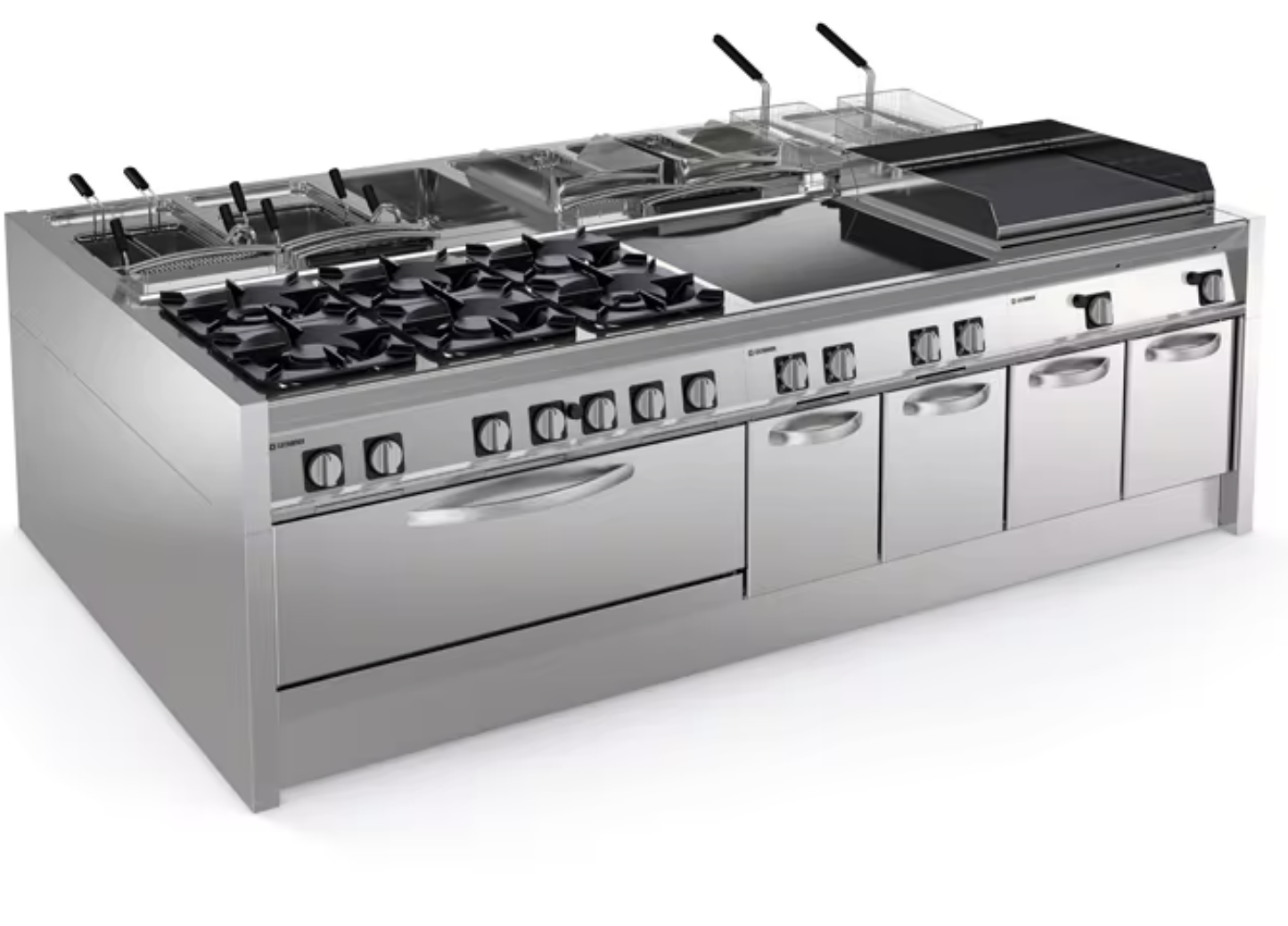
The Range Cooker
Powerful Versatility for Professional Kitchens
Reasons to buy
- Versatility: Allows multiple cooking tasks simultaneously.
- Durability: Built for heavy use, lasts longer.
- Power: Heats up faster, maintains consistent temperature.
Reasons to avoid
- Size: Requires more kitchen space and professional installation.
- Price: Higher upfront and operational costs.
- Maintenance: Requires higher-levels of maintenance than alternatives.
A commercial range cooker serves as the powerhouse of a professional kitchen, offering a versatile cooking solution that can handle a wide variety of tasks simultaneously. It’s equipped with multiple burners, allowing chefs to prepare various dishes at once, thereby enhancing efficiency. With a large oven capacity, these units are perfect for bulk cooking to meet high-volume culinary demands. Often constructed from robust materials like stainless steel, commercial range cookers are designed for longevity, standing up to the rigours of intense daily usage. Many models come integrated with additional features such as griddles or grills, enabling a wide array of cooking techniques. Additionally, they offer precise heat control across cooking stations, ensuring optimal results every time.
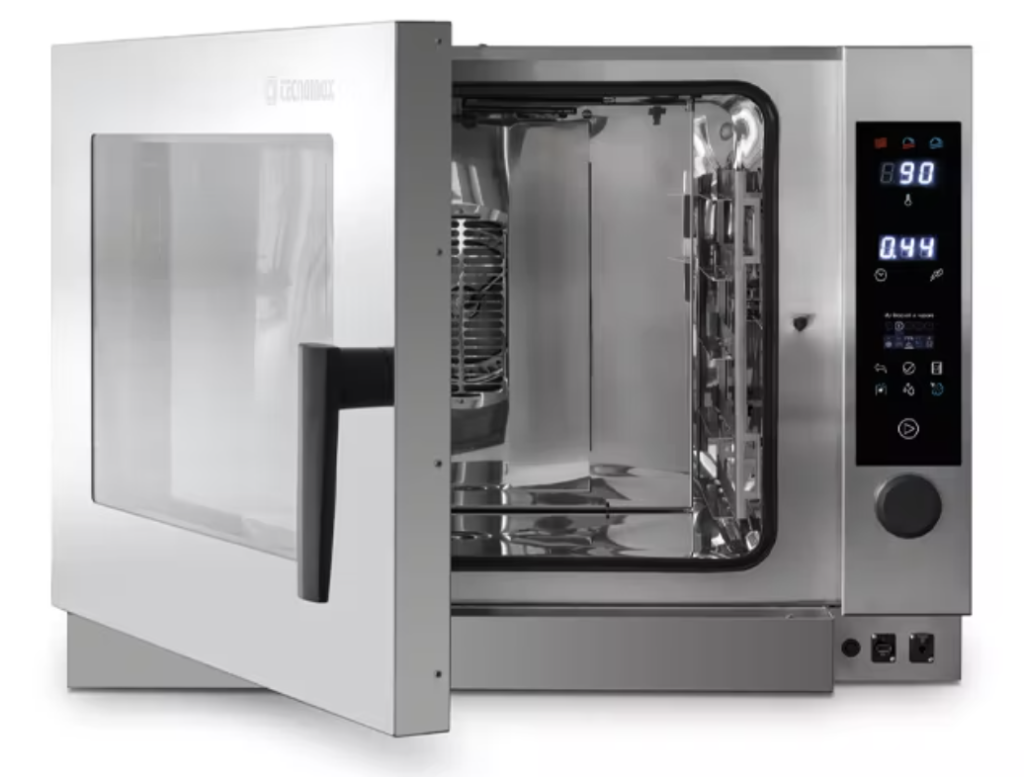
THE COMBI OVEN
Unleashing Culinary Versatility and Efficiency
Reasons to buy
- Multifunctional: Combi’s can steam, roast, and bake.
- Precision: Offers consistent temperature and humidity control.
- Efficient: Cooks food quickly, saving time and energy.
Reasons to avoid
- Cost: More expensive than other types of ovens.
- Complexity: Can be more complicated to operate.
- Maintenance: Requires regular cleaning and servicing.
A combination oven, also known as a “combi oven”, is a highly versatile piece of cooking equipment that incorporates three cooking methods into one appliance: conventional, convection, and steam. The versatility of switching between these cooking methods or using them simultaneously makes the combination oven a popular choice for many professional kitchens.
One of the key advantages of the combination oven is its versatility. The capacity to use steam, convection, or both allows you to prepare a vast array of foods. From baking and roasting to steaming and poaching, you can do it all with this type of oven. Furthermore, similar to convection ovens, combi ovens circulate hot air evenly throughout the oven, ensuring uniformly cooked food. The added advantage of steam also helps to prevent the food from drying out.
Another benefit is its space-saving design. Instead of having separate appliances for convection and steam cooking, a combination oven efficiently combines both, saving precious kitchen space. They also offer efficient cooking, often reducing cooking times compared to traditional cooking methods.
However, combination ovens are usually more expensive than standard convection or steam ovens, which is a considerable downside. The additional cost is due to their multifunctionality.
Another challenge with combination ovens is their complexity. They might pose a steeper learning curve compared to more straightforward oven types, as chefs need to effectively learn when to use each cooking method.
Lastly, these ovens may require more maintenance than simpler appliances. For instance, the steam function necessitates thorough cleaning to avoid the buildup of limescale.
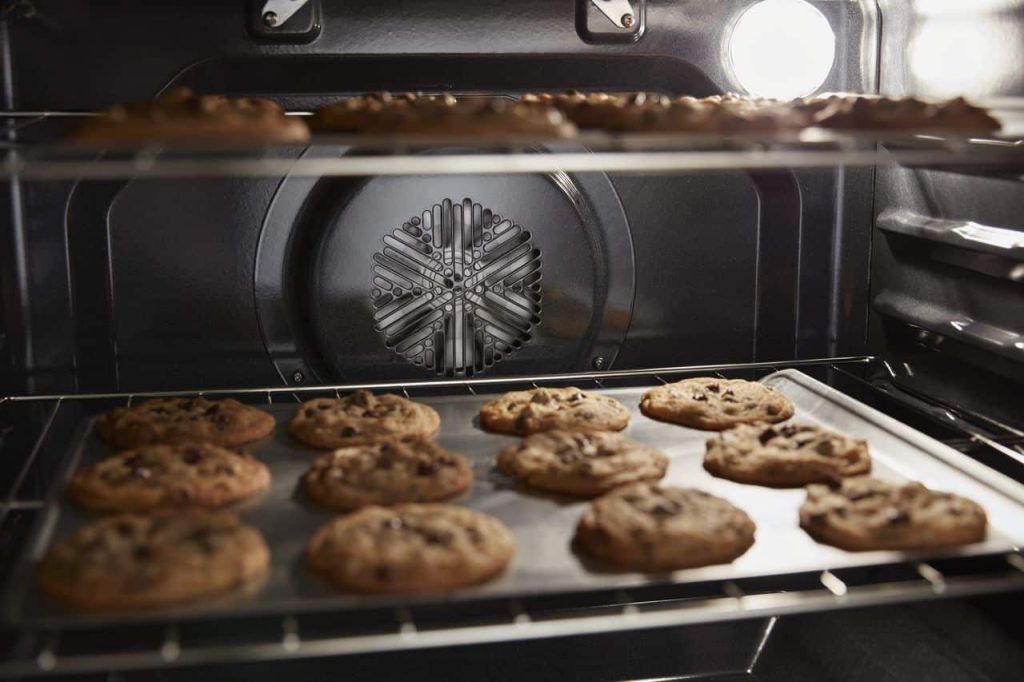
THE COnvection oven
Efficient, Even Heating for Perfect Baking
reasons to buy
- Multifunctional: Combi’s can steam, roast, and bake.
- Precision: Offers consistent temperature and humidity control.
- Efficient: Cooks food quickly, saving time and energy.
reasons to avoid
- Multifunctional: Combi’s can steam, roast, and bake.
- Precision: Offers consistent temperature and humidity control.
- Efficient: Cooks food quickly, saving time and energy.
Convection ovens use fans to circulate hot air and cook food more quickly and evenly. Unlike conventional ovens that have heat sources at the bottom and (sometimes) the top, convection ovens distribute the heat throughout the entire oven cavity. This process results in a consistent temperature across all racks, ensuring that the food is cooked evenly.
One of the primary advantages of convection ovens is their efficiency. The circulation of hot air reduces the required cooking temperature and often results in faster cooking times than traditional ovens. This can be particularly beneficial in a commercial setting where speed is of the essence.
In addition, due to the even heat distribution, you can cook multiple items at the same time without worrying about uneven cooking. This makes convection ovens ideal for baking pastries and bread, as they help to achieve a more consistent and perfect golden brown crust.
Convection ovens can be a bit tricky to master initially, especially for delicate recipes that don’t fare well with rapidly circulating hot air, such as soufflés or other light, airy pastries. The forced air can sometimes create dry conditions inside the oven, which might not suit certain types of cooking.
Convection ovens also tend to be more expensive than conventional ovens, although many cooks find that the benefits outweigh the higher cost.
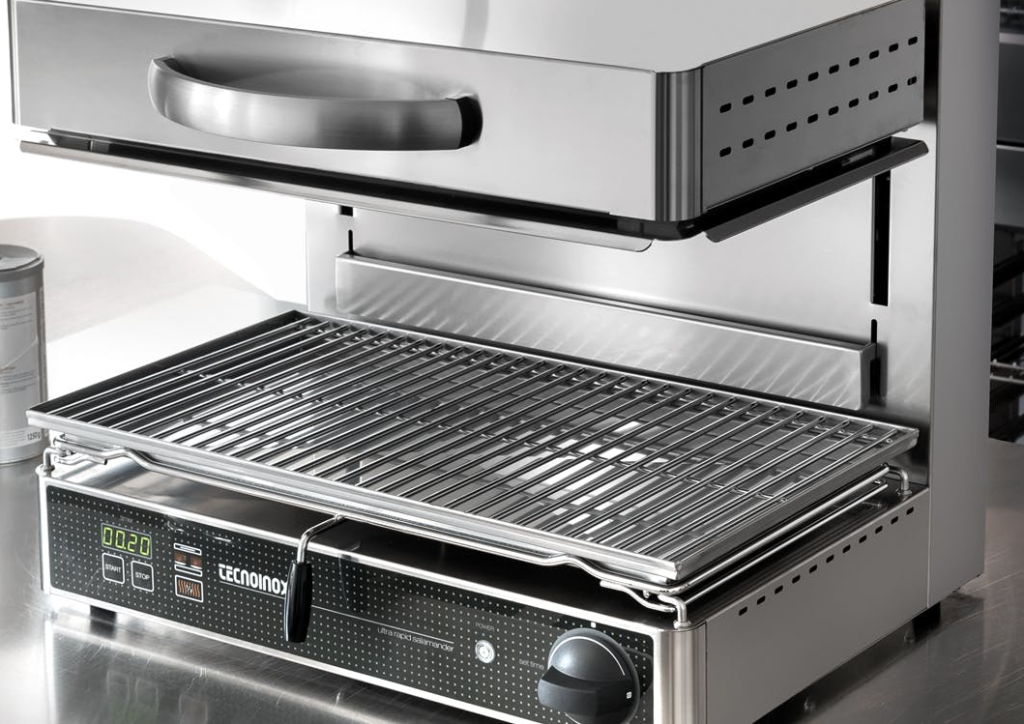
Salamander Grill
High Heat Specialist for Fast Broiling and Browning
reasons to buy
- Multifunctional: Combi’s can steam, roast, and bake.
- Precision: Offers consistent temperature and humidity control.
- Efficient: Cooks food quickly, saving time and energy.
reasons to avoid
- Multifunctional: Combi’s can steam, roast, and bake.
- Precision: Offers consistent temperature and humidity control.
- Efficient: Cooks food quickly, saving time and energy.
A Salamander Grill, often simply referred to as a Salamander, is an overhead high-temperature grill commonly used in professional kitchens for toasting, browning, or maintaining dishes at a set temperature. Available in both gas and electric versions, Salamander Grills are usually mounted on a wall or shelf, making them space-efficient and allowing for easy monitoring of the cooking process.
Salamander Grills can be static or adjustable, with more advanced models allowing the entire top grill section to be raised or lowered. Some models also feature plate detection, meaning they only turn on when a dish is in place, making them energy efficient and consistent.
In comparison with other grills, Salamander Grills force heat downwards onto the food, while standard grills and commercial barbecues let heat rise. Compared to contact grills, which cook both sides of the food simultaneously, Salamander Grills only come into contact with the food via the removable shelf or GN, making them easier to clean.
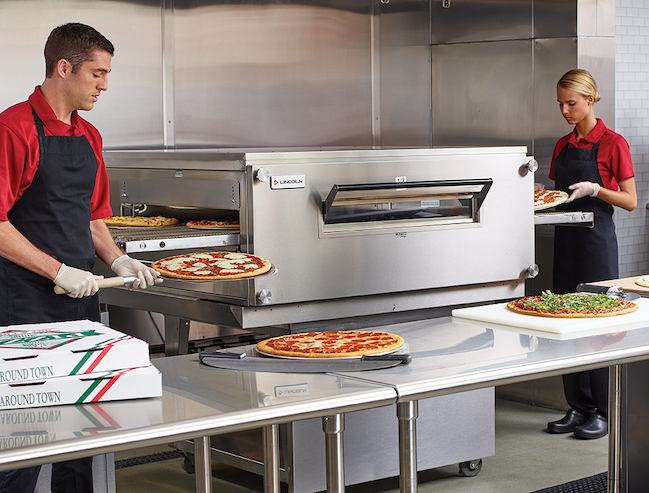
Pizza/Conveyor Oven
Efficient, Even Heating for Perfect Baking
Reasons to buy
- Efficiency: Continuous cooking process accommodates high-volume demand.
- Consistency: Delivers uniform heat for evenly cooked pizzas.
- Ease of Use: Minimal training required, reducing labor costs.”
Reasons to avoid
- Space: Large footprint, requiring ample kitchen space.
- Limited Versatility: Primarily designed for pizza, limiting its multi-use capability.
- Maintenance: Complex parts can be more challenging and costly to repair.
Consider a fast-paced assembly line, but in the form of an oven. That’s the essence of a conveyor oven. It utilises a continuously moving belt to transport food through a heated chamber, ensuring an even, rapid cook. Whether you’re running a pizzeria, a bustling food hall, or a busy takeaway, conveyor ovens are designed to deliver high-volume, consistent cooking.
What sets conveyor ovens apart is their versatility. They come in both gas and electric versions and are available as compact countertop or larger floor models. The larger units are particularly versatile, known not only for pizzas and sandwiches but also for preparing a wide array of foods, even including delicate seafood or baked goods like cookies and brownies.
Size matters when you’re choosing a conveyor oven. They range from small to extra-large, with belt widths between 16 and 38 inches and chamber lengths from 16 to 70 inches. The size impacts not only the space they’ll occupy in your kitchen but also their capacity, with some large models catering to high-volume production.
One exciting aspect of conveyor ovens is the cooking technology they offer. You can choose from forced air, infrared, and gas flame options. Forced-air technology can even reduce pizza baking times by 10% to 30%, a significant time-saver during a busy service.

High Speed Oven
The Powerhouse of Speed and Efficiency
Reasons to buy
- Speed: Extremely fast cooking times, which increases kitchen efficiency.
- Versatility: Able to cook a wide variety of foods, from sandwiches to pizzas.
- Compactness: Small size saves kitchen space and is energy efficient.
Reasons to avoid
- Cost: Higher upfront investment compared to traditional ovens.
- Maintenance: Complex technology may require more frequent and expert maintenance.
- Limitations: Not ideal for large-scale cooking or when traditional cooking methods are preferred.
High-speed ovens, or rapid cook ovens, are a boon for time-sensitive commercial kitchens. By combining the functionalities of convection, microwave, and often impingement, these ovens deliver faster cooking times without sacrificing food quality.
One of the standout features of high-speed ovens is their speed. These ovens can cut down cooking times by up to 20 times compared to traditional ovens, making them a perfect fit for fast-paced settings. They are versatile and can handle a wide range of foods, everything from toasted sandwiches to perfectly baked pizzas.
Another key feature is their compactness. Most high-speed ovens are designed to fit snugly into your kitchen, saving you precious space. On top of this, they are more energy-efficient than conventional ovens due to their reduced cooking times.
High-speed ovens often come with preset cooking programs, offering consistent cooking results regardless of the user. However, there are a few things to be mindful of. High-speed ovens can be quite costly upfront, and their complex technology might demand more maintenance than simpler counterparts. They may not be ideal for large-scale cooking or when traditional cooking techniques are preferred.
Overall, if speed, consistency, and space conservation are high on your priority list, a high-speed oven could be a substantial addition to your commercial kitchen.
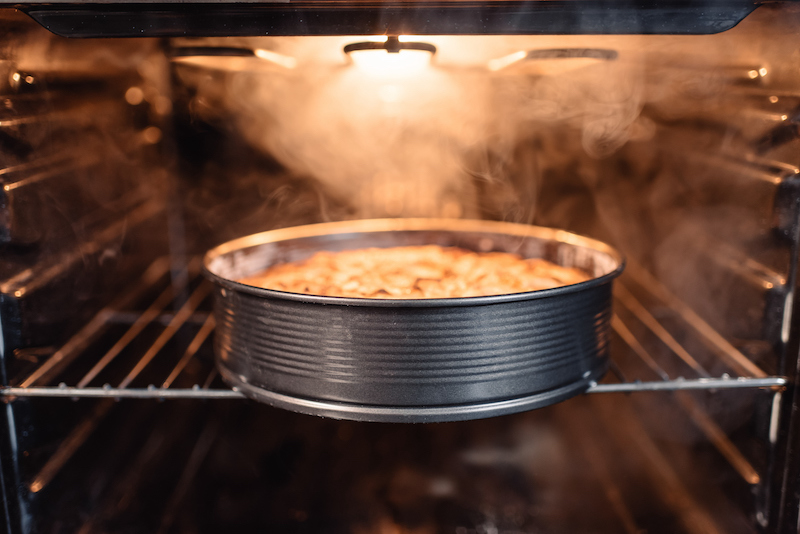
The Steam Oven
Optimised Moisture Control
Reasons to buy
- Retains Nutrients and Flavors: Steam cooking preserves more nutrients and flavors in food.
- Precise Temperature Control: Ensures consistent cooking results.
- Energy Efficiency: Can cook large quantities evenly with less energy.
Reasons to avoid
- No Crispy Finish: Not suitable for foods requiring a crisp exterior.
- Complexity: Can be more complex to operate than conventional ovens.
- Higher Upfront Cost: May have a more significant initial investment.
Steam ovens, as their name suggests, primarily use steam to cook food. This makes them exceptional for preparing food that needs to stay moist and not dry out, such as vegetables, fish, and certain cuts of meat. With precise temperature control, they can cook food at just the right heat to retain nutrients and flavor. Some models even allow for a combination of steam and conventional heat, giving you the versatility of a combi oven. The main challenge with steam ovens is that they are not suitable for foods that need a crispy finish, such as roasted meats or certain baked goods. They can also be a bit more complex to operate than conventional ovens, and may have higher upfront costs. However, their energy efficiency and ability to cook large quantities of food evenly can make them a cost-effective choice in the long run.
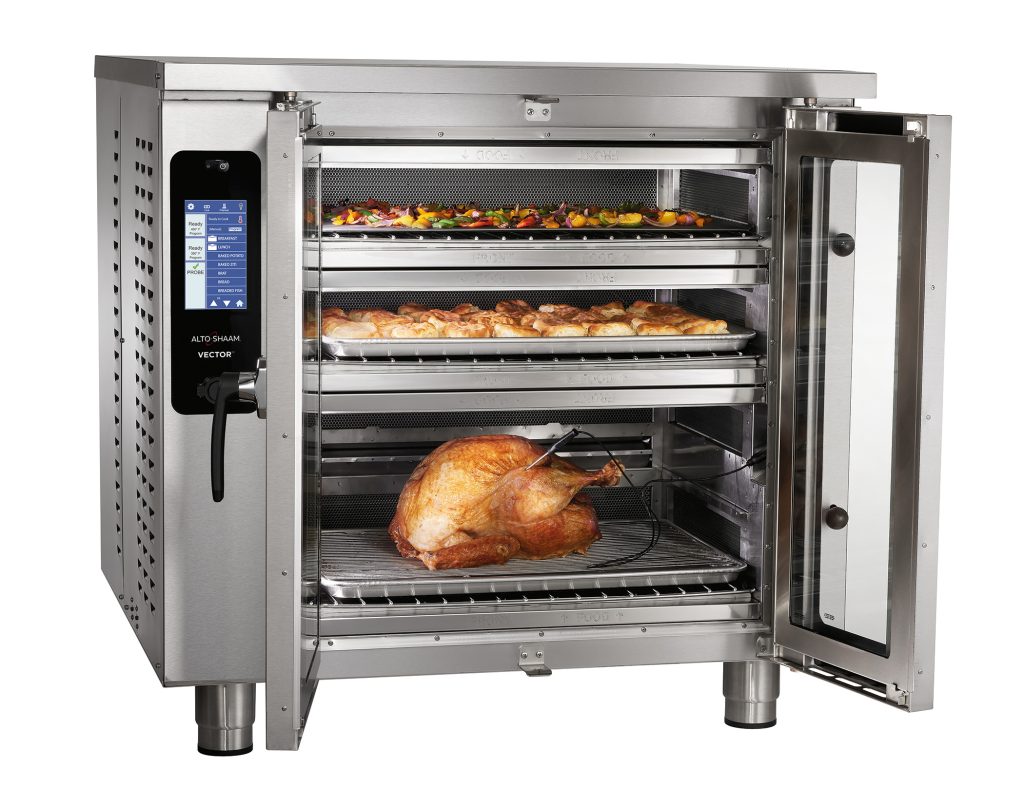
Cook & hold ovens
Efficient, Even Heating for Perfect Baking
Reasons to buy
- Energy Efficiency: They use less energy as they operate at lower temperatures.
- Enhanced Flavor: The slow cooking process can result in more tender, flavorful dishes.
- Safe Temperatures: They keep food at safe serving temperatures, eliminating the need for additional warming equipment.
Reasons to avoid
- Limited Versatility: Not suitable for dishes requiring high-temperature searing or quick baking.
- Occupies Space: They can take up valuable kitchen space.
- Slower Cooking Time: The lower temperatures mean food takes longer to cook, which may not suit all business models.
Cook and Hold Ovens are designed to cook food slowly at a lower temperature and then keep it warm over a period of time. This makes them perfect for certain types of food that benefit from slow cooking, such as roasts or braised dishes.
These ovens use less energy than traditional ovens, as they operate at lower temperatures, often around 200 degrees Fahrenheit or even less. They also keep food at safe serving temperatures, eliminating the need for additional warming equipment. This slow, low-temperature cooking can result in more tender, flavorful dishes.
However, Cook and Hold Ovens might not be suitable for every type of dish, especially those requiring high-temperature searing or quick baking. Also, these ovens may occupy valuable kitchen space and not be as versatile as some other types of ovens.
Which oven is the best for commercial use?
Choosing the best oven for commercial use ultimately depends on the specific needs and goals of your business. However, one type of oven that stands out in popularity and versatility is the combination oven, often known as the “combi” oven.
Combi ovens are a powerful tool in any commercial kitchen. Here’s why:
-
Versatility: Combi ovens offer a range of cooking techniques, including steaming, roasting, braising, smoking, and baking, all in one machine. This can empower your culinary creativity while conserving valuable kitchen space.
-
Ease of Use: Combi ovens are user-friendly, making them an excellent choice for businesses with teams new to the industry. They are also equipped with pre-programme settings, allowing you to create everything from perfect choux pastries to succulent roasts at the push of a button.
-
Efficiency: Combi ovens heat up quickly and efficiently, enabling you to cook meals promptly without compromising taste or texture. This can enhance customer satisfaction and encourage repeat business.
-
Flexibility: With the capacity to accommodate 6-10 stovetop griddles, a combi oven allows you to cook multiple dishes simultaneously. This flexibility can significantly streamline your kitchen operations.
-
Moisture Retention: Combi ovens add moisture during the cooking process, which can improve the yield rate of meats and enhance the overall quality of your dishes.
In short, a combi oven combines versatility, ease of use, efficiency, flexibility, and enhanced cooking quality, making it a highly beneficial addition to any commercial kitchen.
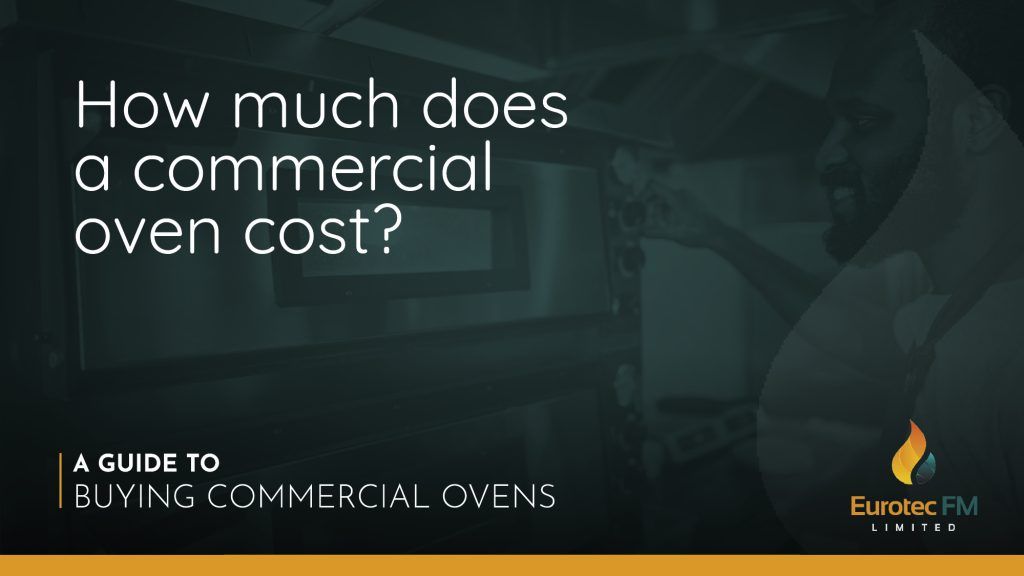
How much does a commercial oven cost?
The investment in a commercial oven varies significantly based on the specific model you select. Factors such as size, design, and storage capacity all influence the price. While you can find options starting around £1,500, high-end models with greater storage space can exceed £10,000.
Before committing to a purchase, it’s crucial to measure your kitchen space to ensure the oven will fit seamlessly into your setup. It’s not just about the physical dimensions; also consider the accessibility for delivery and installation.
Furthermore, it’s worth noting that most commercial ovens come with warranties. This means that if you encounter any issues within the first 1-3 years of ownership, these will typically be addressed free of charge, providing you with added assurance on your investment. This consideration of cost, fit, and warranty can help you make an informed decision that aligns with your budget and kitchen needs.
maintaining your commercial oven
Maintaining your commercial oven isn’t just a necessity; it’s a key ingredient in consistently delivering high-quality food. A clean oven is not only a healthier and safer cooking environment but also a more efficient one.
Here’s why oven maintenance is so vital:
Health and Safety: Accumulated food debris and spillages can burn each time the oven is used, generating smoke and fumes. To maintain a healthy work environment, it’s critical to have an efficient kitchen extraction system to remove these potentially harmful gases.
Food Quality: An unclean oven can adversely affect your dishes’ flavour and quality. Residual food waste can contaminate your freshly cooked meals, potentially making them unsuitable to serve.
Efficiency and Cost: Grease build-up can cause your oven to take longer to heat up and maintain the desired temperature, leading to higher energy consumption and operating costs. Regular cleaning and maintenance can help keep your oven energy-efficient, saving time and money.
Durability: A commercial oven is a significant investment, and you’d want it to last. Regular cleaning helps prevent wear and tear, as a dirty oven has to work harder to function correctly. This could shorten its lifespan significantly.
Regular Servicing: We recommend a quarterly service of your oven to ensure it’s running smoothly. Regular servicing can preempt potential issues, ensuring that your oven continues to perform optimally and safely. Get in touch with our team to learn more about preventative maintenance plans.
By instilling a robust cleaning routine and investing in quality cleaning equipment, you can prolong your oven’s life, reduce running costs, and ensure that your food always meets the high standards your customers expect.
Choosing the right commercial oven is a crucial decision for any foodservice business. With the wide range of options available, from gas and electric ovens to combi ovens, convection ovens, high-speed ovens, and more, it’s essential to understand your specific needs and culinary goals.
A commercial oven is more than just a cooking appliance; it’s a tool that can elevate your culinary journey and create unforgettable dining experiences for your customers. Whether you’re running a pizzeria, a bustling cafe, or a fine-dining restaurant, the right oven can make a significant difference in the taste, texture, and efficiency of your dishes.
Remember to consider factors like energy source, versatility, space requirements, maintenance, and budget when making your choice. And if you’re seeking a versatile and powerful solution, the combi oven stands out as a top contender, providing the ability to steam, roast, bake, and more in one convenient machine.
At Eurotec FM, we offer an extensive range of professional ovens, designed to meet the diverse needs of commercial kitchens. Our team of experts is here to guide you through the selection process and help you find the perfect oven that matches your culinary niche and takes your cooking to the next level.
